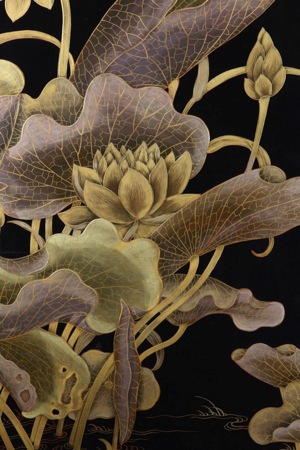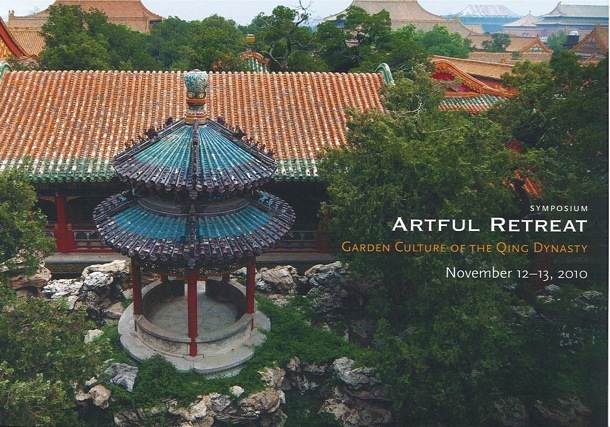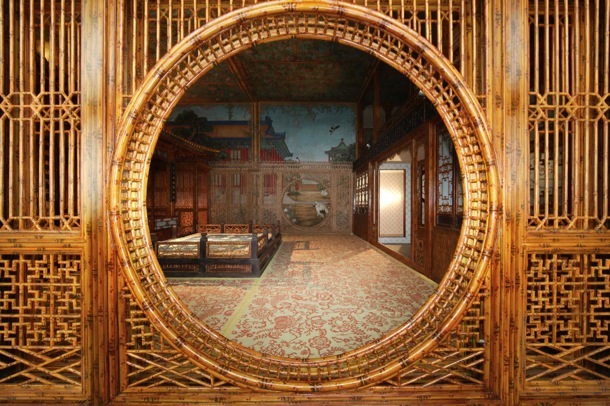|
||||||||||
|
NEW SCHOLARSHIPA Sylvan Symposium 'Artful Retreat: Garden Culture of the Qing Dynasty'Nancy Berliner Curator of Chinese Art Peabody Essex Museum, Salem MA Fig.1 Detail of a screen consisting of sixteen double-sided panels from Yunguang Lou 雲光樓, The Palace Museum. Each panel 84 x 28 x 2 ½ inches (213 x 58.7 x 6 cm). Photograph: courtesy of the Peabody Essex Museum A two-day symposium jointly organized by the Peabody Essex Museum and Harvard University's Fairbank Center for Chinese Studies and Department of History of Art and Architecture, with the support of the Harvard-Yenching Institute, was a sylvan opportunity for scholars from four continents to explore Qing-period garden culture from a multitude of perspectives (click here to visit the symposium website).[Fig.1] This symposium, held on 12-13 November 2010, was scheduled in conjunction with a special exhibition at the Peabody Essex Museum displaying art objects and architectural and garden elements from what is popularly known as the 'Qianlong Garden' (Qianlong Huayuan 乾隆花園—for a discussion of this expression, see the research note, also in New Scholarship in this issue).[Fig.2] This garden was created in 1771-76 by the Qianlong emperor as part of the Ningshou Gong 寧壽宮 retirement precinct in the northeast corner of the Forbidden City. The Peabody Essex Museum of Salem, Massachusetts, organized and presented the exhibit, 'The Emperor's Private Paradise: Treasures from the Forbidden City', in partnership with the Palace Museum, Beijing, and in cooperation with the World Monuments Fund. A collaborative conservation project by the Palace Museum and the World Monuments Fund is in the process of restoring the entire two-acre, twenty-seven-building Qianlong Garden. In keeping with the exhibition and inspiration of the symposium, three speakers took elements of the Qianlong Garden in the Forbidden City as starting points for larger explorations: Eugene Wang 王躍進 (Abby Aldrich Rockefeller Professor of Asian Art at Harvard University) in his paper 'Where Does It All Lead to? The Qianlong Garden as a Spatial Fiction' considered the entire composition of the Qianlong Garden as a readable and interpretable spatial narrative. Liu Chang (Associate Professor at the Tsinghua University School of Architecture and country representative of the World Monuments Fund), who has worked extensively on the Qianlong Garden, presented his paper, 'Jade Conch Pavilion and Beyond: From Pythagoras to Plum Blossoms in China', on the mathematical and architectural analyses of constructing a rare five-sided and five-columned pavilion, Biluo Ting 碧螺亭, in the garden. Nancy Berliner (Curator of Chinese Art at the Peabody Essex Museum, curator of the Emperor's Private Paradise exhibition and interpretive advisor to the World Monuments Fund on the Qianlong Garden conservation project) focused her paper, 'Gardens, Water and Calligraphy: The Development and References of the Curving Waterway Garden Element', on the abstract waterway carved into a stone planks in the Xishang Ting 禊賞亭 pavilion in the Qianlong Garden, and the history and development of such abstracted waterways in Chinese gardens. Luo Wenhua (historian and curator of Buddhist art at the Palace Museum) in his paper, 'From Jiyunlou 吉雲樓 (Building of Fortunate Clouds) to Forilou 佛日樓 (Building of the Buddha-sun): A History of the Development of Qing Imperial Buddhist Halls', pointed out that for the Qianlong emperor gardens often went beyond merely rocks, water and buildings but also encompassed elaborate spaces for Buddhist worship.  Fig.2 Announcement for the symposium 'Artful Retreat: Garden Culture of the Qing Dynasty'
Two of the Qing emperors' other grander garden estates, both of which contained many gardens within gardens—the Yuanming Yuan 圓明園, or Garden of Perfect Brightness, on the outskirts of Beijing and the Imperial Mountain Lodge (Bishu Shanzhuang 避暑山莊) in Rehe 熱河, beyond the Great Wall to the northeast of the former dynastic capital—became subjects for several participants' papers. Four presenters focused their remarks on the Qianlong emperor's introduction of European elements into the Yuanming Yuan. Hui Zou (Professor of architecture at the University of Florida) compared the European concept of labyrinth—represented by the European-style maze, the Wanhuazhen 萬花陣, within the Yuanming Yuan—with the labyrinths of rockeries in Chinese gardens in his paper 'Qianlong's View of Labyrinth: Yuanming Yuan and the Lion Groves'. Staying at this northern end of the Yuanming Yuan with the European-style buildings created by the Qianlong emperor, Kristina Kleutghen (who has done extensive work on illusionistic paintings and is currently co-editor of the journal Modern Art Asia), presented many new perspectives and considerations of the twenty engravings commissioned by the emperor depicting the European palaces in her talk 'How to Picture a Qing Garden: Engraving Qianlong's European Palaces.' 'The Imperial Focal Point: Trompe-l'oeil Perspective Illusions for the Qianlong Emperor in the European Palaces of the Yuanming yuan' by the independent scholar John Finlay, whose research over recent years has also focused on the European-style buildings at the Yuanming Yuan, described the complex arrangement of structures and facades to create monumental three-dimensional illusions. Another three papers examined the landscape further north at the Imperial Mountain Lodge and that landscape as envisioned in poetry and painting. Stephen Whiteman (visiting instructor of Asian Art at Middlebury College) considered the political and social expressions in the designed landscape of that estate in his paper, 'Touring the Rear Park: Landscape and Imperial Intimacy at Bishu Shanzhuang.' In a presentation entitled 'An Imperial Duet: Poems by Kangxi and Qianlong on the Mountain Estate for Escaping the Summer Heat (Bishu shanzhuang)', Richard Strassberg (Professor of Chinese at University of California, Los Angeles) reviewed the construction and expressions in poems about the Mountain Lodge by the Kangxi and Qianlong emperors. The following paper, by Mark Elliott (Professor of Chinese and Inner Asian History in the Department of East Asian Languages and Civilizations at Harvard University), 'Dangerous Gardens: Portraits of Retreat and Rulership in the Qing', complemented the talks by Whiteman and Strassberg by expanding the discussion to include the hunting park at Mulan (Mulan weichang 木蘭圍場) and asking the question, 'If we think of gardens as retreats, then from what was the emperor retreating?' Moving outside the imperial patronage, Xin Wu (a professor at Southwestern University) in her paper 'Rectification of Scholar's Garden under Qianlong' shared research on the establishment and creation of a 'scholars' garden' at the Yuelu Academy (Yuelu Shuyuan 岳麓書院) developed under the direction of its headmaster, Luo Dian 羅典, who had retired from the imperial court. In his presentation, 'The Mind Land of a Modern Leftover Person: Tong Jun and his Study of Jiangnan Gardens', Delin Lai presented the biography and significant contributions of the scholar, Tong Jun (童寯, 1900-83), the twentieth-century researcher and writer who initiated the field of garden studies.  Fig.3 Bamboo entrance and trompe-l'oeil decorations inside the Studio of Exhausted Diligence 倦勤齋. Photograph: courtesy of the Peabody Essex Museum
Broader questions about the meanings, intentions and developments of gardens and larger natural landscapes were examined by several of the speakers. Cary Liu (Curator of Asian art at the Princeton University Art Museum) compared European and American garden and landscape concepts with the ever-changing concepts of gardens in Chinese history in his visually stimulating presentation ' “If all were as it seems”—What is a Chinese Garden?' Independent scholar and curator Tang Keyang's discussion leapt from the concept of gardens to the meaning of mountains that grew out of the context of Qing garden culture. And Wai-yee Li (Professor of Chinese literature at Harvard University) poetically demonstrated in her 'Gardens and Illusions from Ming to Qing' that much can be learned about garden concepts through textual examination of imaginary gardens described by writers. Four panel discussants—Robert Harrist (Professor of Chinese Art History at Columbia University); Maxwell Hearn (Douglas Dillon Curator of Asian Art at the Metropolitan Museum of Art); Jerome Silbergeld (P.Y. and Kinmay W. Tang Professor of Chinese Art at Princeton University); and Rudolf Wagner (Senior Professor for Chinese Studies, University of Heidelberg)—enlightened both the speakers and the audiences with their insightful comments and questions on the papers and topics. In his keynote speech, 'The Fishing Terrace 釣魚臺: Reclusion and Power in the Post-imperial Life of a Qing Garden', Geremie R. Barmé (Professor of Chinese History and Director of the Australian National University's Centre on China in the World) brought together Qing imperial gardens, twentieth-century politics and contemporary state architectural visions with an informative and stimulating presentation on the Diaoyu Tai gardens created by the Qianlong emperor and subsequently inhabited, re-interpreted, decorated and visually recorded by Mao Zedong, his wife Jiang Qing and present day leaders. This final presentation elegantly reinforced the ever-evolving nature and significance of gardens within human culture.[Fig.3] Related material from China Heritage Quarterly:
|